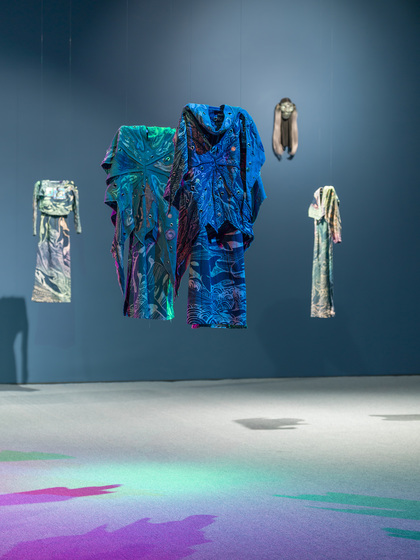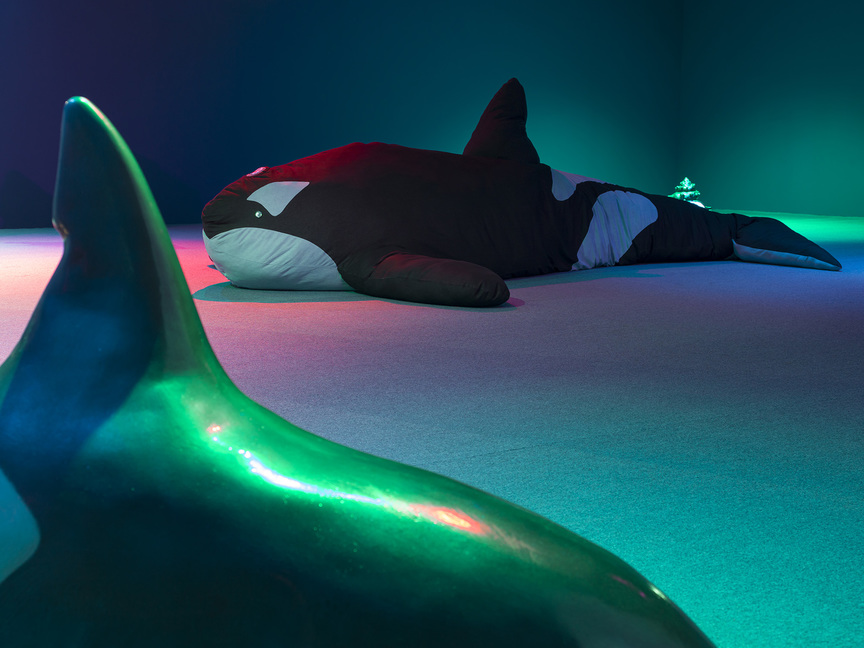-
From Current Issue
-
- Editor’s Letter Fire in the Heart
- Reviews I Gusti Ayu Kadek Murniasih
- Reviews 11th Seoul Mediacity Biennale: “One Escape at a Time”
- Dispatch Networked China
- One on One Monira Al Qadiri on Yukio Mishima
- Essays The rise of independent art spaces in pandemic-era Shanghai
- Features Tuan Andrew Nguyen
- Table of Contents
- Web Exclusives
- Archive
- Subscribe

R
E
V N
E
X
T
Installation view of the costumes worn in ZADIE XA’s performance Grandmother Mago, 2019, mixed media, dimensions variable, at “Child of Magohalmi and the Echos of Creation,” Yarat Contemporary Art Centre, Baku, 2019. All photos by Pat Verbruggen; courtesy the artist and Yarat Contemporary Art Centre.
Child of Magohalmi and the Echos of Creation
Zadie Xa
A procession of five female dancers snaked around the corner of the Venice Biennale’s Central Pavilion and down the tree-lined promenade of the Giardini. Adorned in elaborate robes with rainbow-hued orca and wave motifs, and headwear replete with fins protruding from the top, they broke formation and began to dance to the beat of a drum, their bodies contorting into dramatic shapes with movements simultaneously fluid and aggressive. These gestures, part of Zadie Xa’s performance Grandmother Mago (2019), which debuted at the 58th Venice Biennale, were intended to invoke the spirit of goddess Magohalmi, or Grandmother Mago, who is described in traditional Korean lore and numerous other prehistoric East Asian cultures as the original goddess who came into being through the vibration of cosmic music, and whose granddaughters are the first shamans of the world. In the costumes of Grandmother Mago’s performers, Xa also references an important female animal—an orca named Granny, who was known by scientists to swim in the northeast Pacific Ocean. Some studies show that Granny lived to be 105 years old, making her the oldest orca at the time of her death in 2016. During her lifetime, she trained generations of orca within her pod to survive. Merging these trans-Pacific narratives, the artist explores the power of feminine knowledge across time, and the human and animal worlds, surfacing what has been suppressed by patriarchal systems.
The underscoring of feminine power was similarly at the core of Xa’s solo exhibition at Yarat Contemporary Art Centre in Baku, which featured Child of Magohalmi and the Echos of Creation (2019), an immersive multimedia installation. Stepping into the capacious gallery, gently illuminated with aquatic-toned blue, purple, and green lights, visitors encountered Xa’s performance costumes, including those used in Grandmother Mago, and her masks, inspired by talchum, a Korean mask dance. Audiences were invited to nestle into an orca-shaped beanbag in the center of the room to watch a video, projected on the main wall, of Xa’s performance as a shamanistic figure, alluding to Grandmother Mago. Xa’s body undulates with the movement of the waves that surround her, while the video’s rhythmic soundtrack played through speakers encased in conch shell sculptures. Channeling Grandmother Mago’s spirit through movement and dance—reimaginations of the rituals enacted by Grandmother Mago’s shaman-descendants—Xa celebrates Grandmother Mago as the archetype of female creative energy, and positions her as a guardian of ancient knowledge.
At the same time, the ritual is a means for the artist to connect with her own heritage. Xa was born to a family with Korean ancestry, who relocated across the world to Canada. The designs of the exhibited costumes, on the other hand, pay homage to where the artist was raised, with motifs referencing the traditional iconographies of the Indigenous people of the Pacific Northwest. Xa was also inspired by the life of her maternal grandmother as a strong, matriarchial figure. Though Xa’s grandmother passed away before Xa was born, she has had mythic stature in Xa’s life—Xa only knew her through stories, which she wove into her adaptations of legends and rituals.
The exhibition did not include a live performance by Xa, but instead featured a diverse roster of Azerbaijani artists and performers whose works are in conversation with the same themes, and who used the exhibition as a backdrop. Xa intended to gather various local myths and interpretations of feminine power to find resonances between her works and the practices of artists in the country. Azerbaijan has its own complicated history with regards to the treatment of women—while goddesses were prevalent in the region’s prehistoric narratives, and Azerbaijan was the first Muslim country to give women the right to vote in modern times, it is still a heavily patriarchal and traditional society. Xa’s insistence that the exhibition include local narratives is what gave the presentation such strength. She channeled the complexities of variegated influences with warmth and sensitivity. Her mythologies come from different places across the world, and attest to the fact that these stories are a part of everyone, everywhere.
Zadie Xa’s “Child of Magohalmi and the Echos of Creation” is on view at Yarat Contemporary Art Centre, Baku, until September 29, 2019.
To read more of ArtAsiaPacific’s articles, visit our Digital Library.















